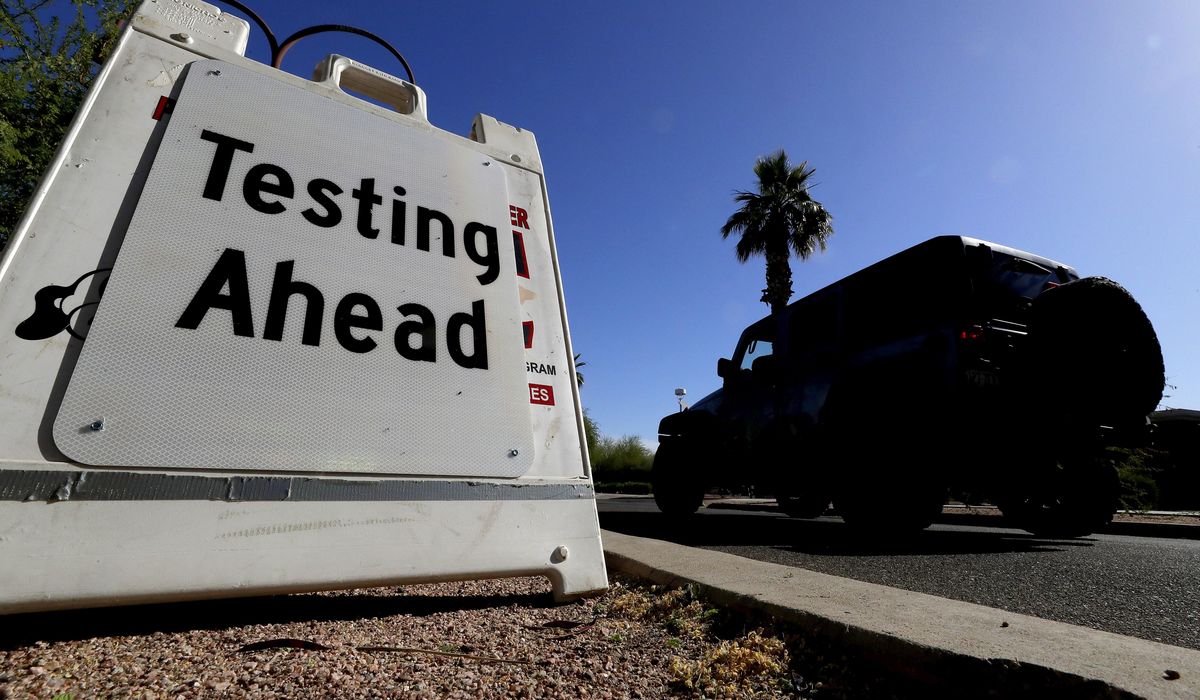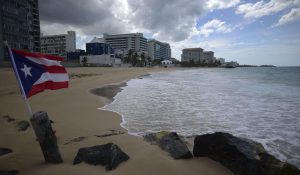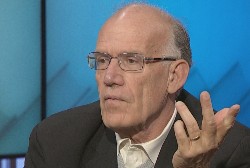Summertime cookouts, beach parties and massive protests against racial injustice are happening outside, giving the coronavirus a chance to drift off with the breeze and tempering fears of a second wave of infections.
But as the mercury climbs, experts also warn of a “reverse” seasonal effect: When it gets too hot, folks will retreat inside, close the windows and crank up the air-conditioning, potentially squandering seasonal gains as U.S. infections surpass 2 million and the death toll exceeds 113,000.
Fears that the U.S. COVID-19 cases are heading up again helped send stocks plummeting on Wall Street Thursday, underscoring how tightly linked the economy and investor confidence are to the health crisis. The Dow Jones Industrial Average dropped over 1,800 points, or 6.9%, its biggest daily dive in three months, while the S&P 500 plunged 5.7% and the Nasdaq Composite slid 5.3%.
A summer spike is a particular worry in places like Arizona and Texas, which have seen a surge in hospitalizations in recent days after state officials relaxed stay-at-home rules weeks ago.
“It’s a hundred degrees in Phoenix right now, 95 degrees in Houston, [and] people are being driven indoors more, so you’re having more congregate settings inside and that could also be contributing to the spread,” former Food and Drug Commissioner Scott Gottlieb said Thursday on MSNBC.
There is evidence the coronavirus doesn’t fare well in natural light, and epidemiologists have been hoping warm weather and higher humidity will knock virus droplets to the ground faster, akin to how other viruses behave. Being outdoors also provides the benefit of “unlimited dilution” of the virus with the wind.
But sometimes it’s just too steamy out. Experts say people should increase ventilation when they head inside, especially if they’re gathering with others.
“Open your windows, bring in more fresh outdoor air. In your car, roll down your window. When you’re outside, we get that benefit already,” Joseph Allen, assistant professor of exposure assessment science in the Department of Environmental Health at Harvard T.H. Chan School of Public Health, said in one of the school’s daily COVID-19 briefings.
The benefits of airflow are why public officials are closing streets to give restaurants more outdoor seating, or cafes are directing customers to their patios.
Inside, scientific studies have shown businesses that open bay doors and opposing windows can sweep away other pollutants, such as diesel exhaust or byproducts from metal-working fluids.
If open windows aren’t an option, the goal with air-conditioning systems is to increase airflow from clean sources and to use the best filtration settings.
“Indoors, you’re primarily looking at diluting the virus or any pollutant by adding air, and ideally air from outdoors is better than recirculated,” said Pete Raynor, a professor of environmental health sciences at the University of Minnesota’s School of Public Health.
‘Cooling centers’
The Centers for Disease Control and Prevention has an entire web page dedicated to preventing COVID-19 transmission at “cooling centers” that provide relief from another public health threat — extreme heat.
The agency urges centers to put people who exhibit COVID-19 symptoms into separate rooms. Everyone at the centers should maintain physical distancing of 6 feet or more.
The agency says that, if possible, the centers should have high ceilings and use high-efficiency filters in their HVAC systems.
Generally speaking, experts say anyone who is stuck inside should wash their hands frequently and adhere to social distancing. Mask-wearing can also help slow the spread.
President Trump’s reelection campaign announced Thursday it will hold its first rally since March at the BOK Center, an indoor arena, in Tulsa on June 19.
The press announcement did not outline any social-distancing measures. However, the general admission request for tickets asks attendees to assume the risk of infection.
“By clicking register below, you are acknowledging that an inherent risk of exposure to COVID-19 exists in any public place where people are present. By attending the rally, you and any guests voluntarily assume all risks related to exposure to COVID-19 and agree not to hold Donald J. Trump for President, Inc.; BOK Center; ASM Global; or any of their affiliates, directors, officers, employees, agents, contractors, or volunteers liable for any illness or injury,” the webpage says.
Meanwhile Vice President Mike Pence, who leads the White House coronavirus task force, caused a stir by tweeting a Wednesday photo of himself with a large group of mask-less Trump campaign staffers who packed together in an indoor office building. The tweet was later deleted.
“The vice president yesterday was photographed with campaign staffers in a tight space, no social distancing, without anyone wearing a mask,” Senate Minority Leader Charles E. Schumer said. “The very least the administration could do is lead by example and often cannot even manage that much.”
Mr. Schumer, New York Democrat, demanded a briefing on the national COVID-19 situation from key scientists on the White House coronavirus task force — doctors Deborah Birx and Anthony Fauci — saying the U.S. needs to refocus on the issue.
“The disease is spiking in a number of states around the country. Arizona officials have warned that its hospitals could be filled by next month,” he said. “Texas has gone three straight days with record numbers of hospitalizations. North Carolina, New Mexico, California, Oregon, and several other states are experiencing a resurgence, or peak-levels of COVID-19.”
Experts fear the lack of social distancing is fueling cases, as business reopenings bring people into closer contact. There have also been massive protests against police brutality in the wake of George Floyd’s death in Minneapolis, fueling fears of increased transmission among the densely packed crowds.
Ashish Jha, the director of the Harvard Global Health Institute, said even without any spikes over the summer, there will continue to be 800 to 1,000 coronavirus-related deaths per day in the U.S.
“Over the next three months, we will cross the 200,000 mark,” he told NBC’s “Today” program on Thursday. “Sometime in September, we’re going to cross 200,000 and we still won’t be done.”
He’s concerned about recent upticks in cases in states like Arizona, North Carolina, South Carolina, Texas, and Florida.
“I had hoped that the fact that people are spending more time outside, that it’s summer we would not see such a big increase so fast,” he said. “It’s more concerning than I had hoped we would get at this point.”



















